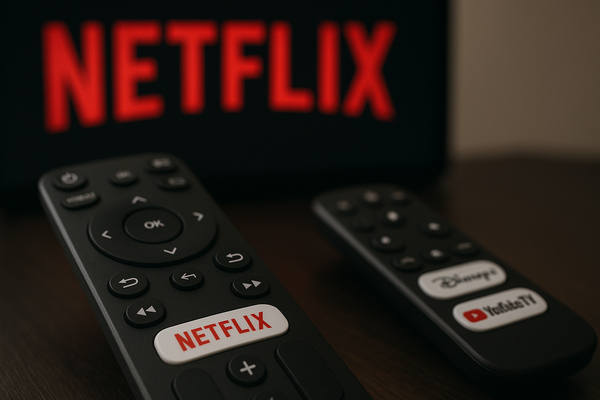
Netflix weakness and Disney’s carriage fight with YouTube TV are driving trader attention this week. Netflix’s post-earnings sell-off forced some reallocations, while Disney’s warning about potential ESPN and ABC blackouts sharpened concerns over distribution revenue and subscriber churn. In the near term traders are repositioning around earnings reaction and content delivery risk. Over the medium term, pricing power, ad monetization and rights negotiations will determine winners across content owners and distributors in the US, Europe and parts of Latin America.
Streaming tension: earnings, subscribers and distribution fights
Investors reacted to the latest round of streaming news with fresh skepticism. Netflix reported revenue of $11.51 billion and highlighted advertising gains and price increases, yet the stock fell after the quarter on an apparent miss to some expectations. That created a classic buy-the-dip narrative that institutional managers and prominent retail-focused funds debated over the next trading sessions.
Meanwhile Disney escalated a distribution dispute with YouTube TV that could black out ESPN and ABC for millions of viewers if no deal is struck. Distribution disputes are not new, but they matter now because they touch live sports rights, linear bundle economics and short-term churn. A blackout could accelerate subscriber losses for MVPD substitutes and dent advertising inventory at the same time networks face rising production costs.
Warner Bros. Discovery remains part of the equation. Commentary about potential mergers or sales has surfaced again, and market chatter has pushed trading in legacy studios because any consolidation would reprice content libraries and streaming scale. Jim Cramer’s comments urging investors to hold Warner Bros. Discovery signal the level of retail and adviser focus on deal outcomes.
Cable carriers and broadband: cord-cutting pressure vs yield appeal
Incumbent distributors continue to face secular cord-cutting that has accelerated since 2010. Charter’s shrinking cable customer base was highlighted this week, and the company heads into earnings with expectations of ongoing pressure on legacy video revenue. That trend raises short-term downside risk to revenue per user for cable operators and forces a strategic emphasis on broadband expansion and content retransmission fees.
At the same time Comcast’s recent dividend increase and messaging around consistent yield have refocused income-oriented flows into large-cap media names. Income investors are trading around reliability of cash returns as rate expectations change. That creates a bifurcated market: traders short legacy cable exposure tied to subscriber erosion, while longer-duration income buyers lean into stable cash generation from broadband and theme-park recoveries where applicable.
Policy and macro variables amplify the trade. If consumer discretionary spending weakens or a Fed-rate narrative shifts, discretionary ad budgets and subscription take rates could compress. Conversely, a steadier macro backstop would make yield stories more attractive, supporting higher multiples for companies showing reliable free cash flow.
Alternative media, creator monetization and M&A flows
Smaller, alternative platforms are reshaping monetization. Rumble’s announcement to roll out Bitcoin tipping for its 51 million monthly users and the partnership with Tether is an example of creator monetization innovation that could pull creator time and ad dollars away from incumbents. That development matters to traders because it changes revenue mix assumptions for digital-video platforms and may widen valuation dispersion.
On the corporate action front Grindr’s receipt of a non-binding $18 per share take-private proposal valuing the business at roughly $3.5 billion pushed shares higher on heavy volume. That transaction talk is a reminder that strategic buyers and large shareholders are active when user-growth trajectories stall. For traders, buyout bids create windows for event-driven strategies and put pressure on peers with weak growth to seek similar outcomes.
Implied valuation moves in smaller names can cascade into larger names when investors reassess multiples for growth vs monetization. That makes M&A and control transactions a real-time input to sector positioning, especially for companies with heavy insider stakes or concentrated ownership.
Investor reaction: flows, sentiment and volume patterns
Market participants described recent action as a mix of profit-taking, speculative buying and rotation into income names. Netflix saw both heavy selling after the earnings print and tactical buying from high-conviction funds; Cathie Wood’s ETF purchases were noted as a buy-the-dip signal in some desks. Comcast’s dividend messaging drew steady inflows from yield-sensitive funds, while Charter’s pre-earnings caution attracted short interest from a subset of hedge funds.
Trading volumes spiked around corporate actions and distribution disputes. Grindr’s buyout proposal produced a clear volume surge and a double-digit intraday move, consistent with event-driven patterns. Rumble’s product news generated headline trading without the same volume signature, which suggests a longer runway for adoption rather than an immediate monetization shock.
Sentiment indicators show elevated dispersion. Analysts have been issuing varied takes — some leaning toward holding positions on deal speculation for studios, others flagging subscriber risk for streaming incumbents — which supports a market structure with tactical opportunities for both directional and pairs trades.
What to Watch Next
- Distribution negotiations: watch any formal update between Disney and YouTube TV. A blackout announcement or last-minute deal would be a short-term catalyst for both content owners and distributors.
- Earnings cadence: upcoming results for Charter and Comcast will provide fresh data on subscriber trends, ARPU direction and content cost pressure.
- M&A signals: monitor rumors and filings around Warner Bros. Discovery and any renewed third-party interest. Take-private activity like the Grindr proposal often presages broader deal appetite in small-cap media.
- Ad market indicators: any early read on advertising demand from Q4 budgets will materially affect ad-supported streaming assumptions.
- Creator monetization rollouts: adoption metrics or partnership announcements from Rumble and similar platforms will inform revenue mix adjustments for larger players.
Traders will find opportunities in both event-driven and macro-linked trades. Short-term tactics include trading around blackout headlines and earnings windows. Meanwhile, monitoring flows into yield-focused names and M&A headlines will be essential for positioning across the next month. Keep watching distribution contracts, quarterly subscriber disclosures and any new buyout activity as the primary catalysts that will move prices and volume.












